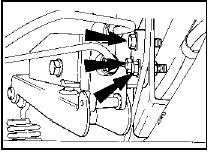Load apportioning valve P100 models) - removal and refitting
Caution: Refer to the precautions in Section 1.
Removal
1 Chock the front wheels, jack up the rear of
the vehicle and support on axle stands (see
“Jacking and Vehicle Support”).
2 The load apportioning valve is located on the right-hand side of the vehicle underbody above the axle.
3 Remove the spring clip and clevis pin, and detach the spring from the valve operating lever (see illustration).

24.3 Remove the spring clip (arrowed) and clevis pin from the valve operating
lever
4 Place a suitable container beneath the valve to catch spilt fluid, then unscrew the union nuts and disconnect the fluid pipes.
Plug the open ends of the pipes and valve to prevent fluid leakage and dirt ingress.
5 Unscrew the three securing nuts and bolts from the valve mounting bracket, and remove the valve assembly (see illustration).

24.5 Load apportioning valve securing bolts (arrowed)
Refitting
6 Refitting is a reversal of removal, but note
that the fluid inlet pipe from the master cylinder
must be connected to the lower valve port, and
the fluid outlet pipe to the rear brakes must be
connected to the upper valve port.
7 On completion, bleed the rear hydraulic circuit and check the valve adjustment.
See also:
Radiator fan - removal and refitting
All models except RS Turbo
Removal
1 Disconnect the battery negative terminal.
2 Disconnect the wiring plug at the fan motor
and unclip the wiring from the shroud.
3 On pre-1986 models the fan sh ...
Bonnet release cable - removal and refitting
Removal
1 Working inside the vehicle, extract the three
screws and remove the steering column
shroud. Open the bonnet. If the cable is broken,
the release latch must be operated using a
suitably ...
Alternator - testing
Note: To carry out the complete test procedure
use only the following test equipment - a 0 to
20 volt moving coil voltmeter, a 0 to 100 amp
moving coil ammeter, and a rheostat rated at
30 amps.
1 ...
